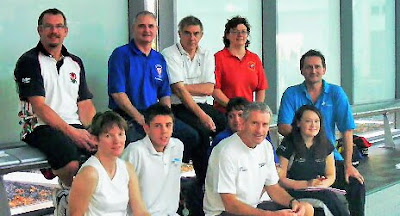- What artefacts inside and outside your organisation have created (or could create) points of focus for you and your colleagues when it comes to developing accessible learning resources?
Examples of internal artefacts might include a policy, an inaccessible resource that a student has complained about or a new module outline that you are developing.
Examples of external artefacts might include an article you have read, a proprietary authoring tool or guidelines on a website.
(AGENCY = a 50 or less web agency that specialises in the creation of e-learning. Some the 'Kall-Kwik' for e-learning, what would have been leaflets, posters, linear video or afternoon workshops turned into e-learning on a tight budget and schedule - slick production in a team of six+ specialists - previously linear video for facilitated workshops, or video with a workbook, then interactive on disc, before moving to intranets and online.)
(CLIENT = a national or multinational of 10,000+ employees hungry for training, both compliance and management training. Keen to exploit e-learning tools and eagerly trying to use social learning too. I have worked for very many and inside a few.)
Professionally I have worked 20 years in the latter and 2 years in the former.
(SWIMMING = from the perspective of a 1000+ club that is five clubs in one offering: teaching and competitive swimming, mastes, waterpolo and disability swimming. As a coach and club officer I have been involved in teaching, coaching, swimming, implementing change and undertaking every four years a mamoth audit called 'Swim21' that leads to the creation of an Improvement Plan. Equity, Disability and Child Protection, Data Protection and Personal Development are key relevant issues)
AGENCY - Style Guide, ISO 9000?, Web Usability, Training, Experience, Exposure …
CLIENT - Style Guide, Mission, Vision, Corporate Responsibility …
SWIMMING - Improvement Plan for Swim21, Disability Officer Role Description, National Disability Classification for competitive swimmers, CPD as workshops and online. Two groups of for disabled swimmers. Regional hub. +ve/-ve outcomes of the Paralympics.
-
Are there any artefacts that you think you and your colleagues have over-relied on or misused to the point that they are now negatively influencing your practice? If so, why do you think this is?
AGENCY - JAWS Screenreader, the browser will sought it out … a PDF once we’ve finished.
CLIENT - policy and a person, Style Guide
SWIMMING - Swim21, the experience of those working with disabled people.
-
Is there any evidence for mutual engagement, joint enterprise or shared repertoire in the community (or communities) you belong to?
AGENCY - none
CLIENT - token, until you see Take3 video
SWIMMING - with local special needs schools, severe disabilities, dyslexia and in mainstream.
-
What has influenced whether or not the people in your community are all working in pursuit of the same accessibility enterprise or objective?
AGENCY - None
CLIENT - HR by organisation
SWIMMING - forcing hand to get one or one or two into an equity course, more onto disability and as a requirement onto child protection which is relevant.
-
Seale discusses the development of accessibility within an organisation as the creation of a constellation of practice rather than a community of practice. How helpful do you think this approach is?
AGENCY - piecemeal, turn it on like a switch, distraction for the most junior.
CLIENT - probably
SWIMMING - Yes, with the ASA the sun, outlying planets and their satellites.
Yes, as the efforts of one trying to be everyone and be everywhere doesn’t work, not will a constellation of people in silos.
-
Do you think that the model shown in Figure 13.1 on page 182 would be useful as a trigger for discussion within your organisation?
The McKinsey model also highlights the fact that, in creating whole organisational change, attention must be paid to different elements of the organisation. This supports our findings about the need to take a multi-pronged approach, be systematic and holistic, take an embedded approach, and target multiple institutional functions. May and Bridger (2010:96) The Seale (2006) puts people into silos.


I find the constellation of communities works as a metaphor that might be a children’s round-about or the petals of a flower. It gets everything into one place, but it doesn’t suggest how they interact. The MsKinsey 7S model on the other hand, developed by a global management consultancy and regularly applied to organizational and team problems, is a tool that can be understood and applied in your context to help identify and solve complex problems.
See The McKinsey 7S Framework, Mind Tools (1995–2009) http://www.mindtools.com/pages/article/newSTR_91.htm
-
Would it enable you and your colleagues to identify what changes or developments are needed and why they are needed?
AGENCY - yes, if a crisis occurs or there is a budget to stand back and take a look at what is going on.
CLIENT - bottom line and society …
SWIMMING - audit, action team, top to bottom, holistic, time … introduce, understand, apply.
-
Would the labels on the figure be different for your organisation? If so, how and why?
Yes, because none of my contexts are in Higher Education. I look at the diagram, then at a room full of people. Many people will be in several ‘communities’ so the model quickly breaks down.
REFERENCE
May, H. and Bridger, K. (2010) Developing and Embedding Inclusive Policy and Practice in Higher Education, York, The Higher Education Academy; also available online at http://www.heacademy.ac.uk/ assets/ York/ documents/ ourwork/ inclusion/ DevelopingEmbeddingInclusivePolicyPractice_ReportFinal.pdf (last accessed 28 August 2012).
Seale, J. (2006) E-Learning and Disability in Higher Education: Accessibility Research and Practice, Abingdon, Routledge; also available online at http://learn2.open.ac.uk/ mod/ subpage/ view.php?id=153062 (last accessed 28 August 2012).
Wenger, E. (1998) Communities of Practice: Learning, Meaning and Identity. Cambridge: Cambridge University Press.
